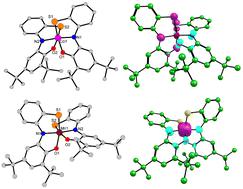当前位置:
X-MOL 学术
›
Dalton Trans.
›
论文详情
Our official English website, www.x-mol.net, welcomes your
feedback! (Note: you will need to create a separate account there.)
Where is the unpaired electron density? A combined experimental and theoretical finding on the geometric and electronic structures of the Co(III) and Mn(IV) complexes of the unsymmetrical non-innocent pincer ONS ligand
Dalton Transactions ( IF 3.5 ) Pub Date : 2022-10-11 , DOI: 10.1039/d2dt01868c
Prasenjit Sarkar 1 , Amrit Sarmah 2, 3 , Chandan Mukherjee 1
Dalton Transactions ( IF 3.5 ) Pub Date : 2022-10-11 , DOI: 10.1039/d2dt01868c
Prasenjit Sarkar 1 , Amrit Sarmah 2, 3 , Chandan Mukherjee 1
Affiliation

|
The tridentate pincer ligand [LONS]3− with the ONS donor set was generated in situ by cleaving the disulfane linkage of the pristine redox-active H4Sar(AP/AP) ligand during the complexation reaction with Co(II) and Mn(II) salts in the presence of air and Et3N. X-ray crystal structure analysis of the Co complex (1) and Mn complex (2) revealed that both the complexes were neutral in charge and six-coordinate with the meridional coordination of the two pincer [LONS]n− ligands. The Co ion was in the trivalent state, while the Mn ion was in the tetravalent state. Thus, the generated two pincer [LONS]3− ligands were non-innocent and cumulatively were in trinegative and tetranegative charges for the respective complexes. The intraligand bond distances of the coordinating ligands in each complex were similar, implying the same oxidation/electronic structure of the two ligating units. Variable-temperature magnetic susceptibility measurements revealed an S = 1/2 ground state for each complex. X-band EPR measurements unambiguously established the presence of a ligand-based unpaired electron in complex 1, and in complex 2, the unpaired electron was at the Mn centre. DFT-based theoretical calculations suggested the three-electron oxidation of the two ligating units in complex 1. Two iminosemiquinone radicals were of opposite spins (α-spin and β-spin) and a thiyl radical in either α-spin or β-spin was delocalized between two sulfur atoms. Thus, the antiferromagnetic coupling among the two opposite spins provided an S = 1/2 ground state and resulted in the radical-based EPR spectrum. In complex 2, each ligating pincer unit contained an iminosemiquinone radical that interacted antiferromagnetically with the Mn(IV)-based three unpaired electrons. This rendered a doublet ground state with the residual electron density located at the Mn center.
中文翻译:

不成对电子密度在哪里?不对称非无辜钳形 ONS 配体的 Co(III) 和 Mn(IV) 配合物的几何和电子结构的实验和理论发现
在与 Co( II ) 和 Mn的络合反应过程中,通过裂解原始氧化还原活性 H 4 Sar (AP/AP)配体的二硫烷键,原位生成具有 ONS 供体组的三齿钳配体 [L ONS ] 3- ( II ) 空气和 Et 3 N存在下的盐。 Co 配合物 ( 1 ) 和 Mn 配合物 ( 2 )的 X 射线晶体结构分析表明,这两种配合物都是电荷中性的,与经向配位为六配位。两个钳子的 [L ONS ] n -配体。Co离子处于三价状态,而Mn离子处于四价状态。因此,生成的两个钳形[L ONS ] 3-配体是非无辜的,并且对于各自的配合物累积地处于三负电荷和四负电荷。每个配合物中配位体的配体内键距离相似,这意味着两个配位单元的氧化/电子结构相同。变温磁化率测量揭示了每个复合物的S = 1/2 基态。X 波段 EPR 测量明确地确定了复合物1和复合物2中存在基于配体的未配对电子,未配对的电子位于 Mn 中心。基于 DFT 的理论计算表明复合物1中的两个连接单元发生了三电子氧化。两个亚氨基半醌自由基具有相反的自旋(α-自旋和β-自旋),并且α-自旋或β-自旋中的硫基自由基在两个硫原子之间离域。因此,两个相反自旋之间的反铁磁耦合提供了S = 1/2 基态并导致基于自由基的 EPR 谱。在复合物2中,每个连接钳形单元包含一个亚氨基半醌自由基,该自由基与基于 Mn( IV ) 的三个不成对电子发生反铁磁相互作用。这呈现了双峰基态,残余电子密度位于 Mn 中心。
更新日期:2022-10-11
中文翻译:

不成对电子密度在哪里?不对称非无辜钳形 ONS 配体的 Co(III) 和 Mn(IV) 配合物的几何和电子结构的实验和理论发现
在与 Co( II ) 和 Mn的络合反应过程中,通过裂解原始氧化还原活性 H 4 Sar (AP/AP)配体的二硫烷键,原位生成具有 ONS 供体组的三齿钳配体 [L ONS ] 3- ( II ) 空气和 Et 3 N存在下的盐。 Co 配合物 ( 1 ) 和 Mn 配合物 ( 2 )的 X 射线晶体结构分析表明,这两种配合物都是电荷中性的,与经向配位为六配位。两个钳子的 [L ONS ] n -配体。Co离子处于三价状态,而Mn离子处于四价状态。因此,生成的两个钳形[L ONS ] 3-配体是非无辜的,并且对于各自的配合物累积地处于三负电荷和四负电荷。每个配合物中配位体的配体内键距离相似,这意味着两个配位单元的氧化/电子结构相同。变温磁化率测量揭示了每个复合物的S = 1/2 基态。X 波段 EPR 测量明确地确定了复合物1和复合物2中存在基于配体的未配对电子,未配对的电子位于 Mn 中心。基于 DFT 的理论计算表明复合物1中的两个连接单元发生了三电子氧化。两个亚氨基半醌自由基具有相反的自旋(α-自旋和β-自旋),并且α-自旋或β-自旋中的硫基自由基在两个硫原子之间离域。因此,两个相反自旋之间的反铁磁耦合提供了S = 1/2 基态并导致基于自由基的 EPR 谱。在复合物2中,每个连接钳形单元包含一个亚氨基半醌自由基,该自由基与基于 Mn( IV ) 的三个不成对电子发生反铁磁相互作用。这呈现了双峰基态,残余电子密度位于 Mn 中心。







































 京公网安备 11010802027423号
京公网安备 11010802027423号